The People and the Land are One
Two Brothers Ski a Mountain That Defines Their People
Words by Leslie Anthony / Photos by Blake Jorgenson
Behind them was the drop-off on the saddle, the high-five powder run down a sunny backside bowl, and the long skin to the base of the summit ridge. There was the sweaty bootpack up a steep wall of snow, and the discovery they’d missed the couloir and would have to rope up a rock-and-ice step for access. Finally, there was the short slide to the entrance and rappel into a chute that would have welcomed them with a foot of powder had it not been cleaned out by a bus-sized chunk of unlucky cornice fall.
And now here they all stood, in heavy shadow, on a narrow platform hacked into the precipitous slope, a pair of tremulous teens, their coach/mentors, two guides, and a cameraman or three, about to realize a landmark dream.
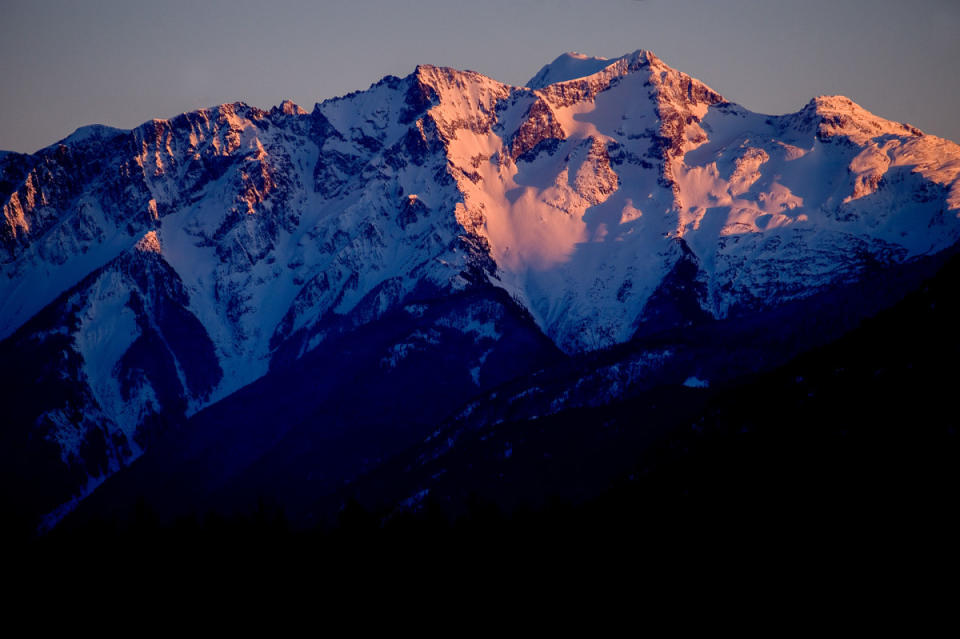
Photo: Blake Jorgenson
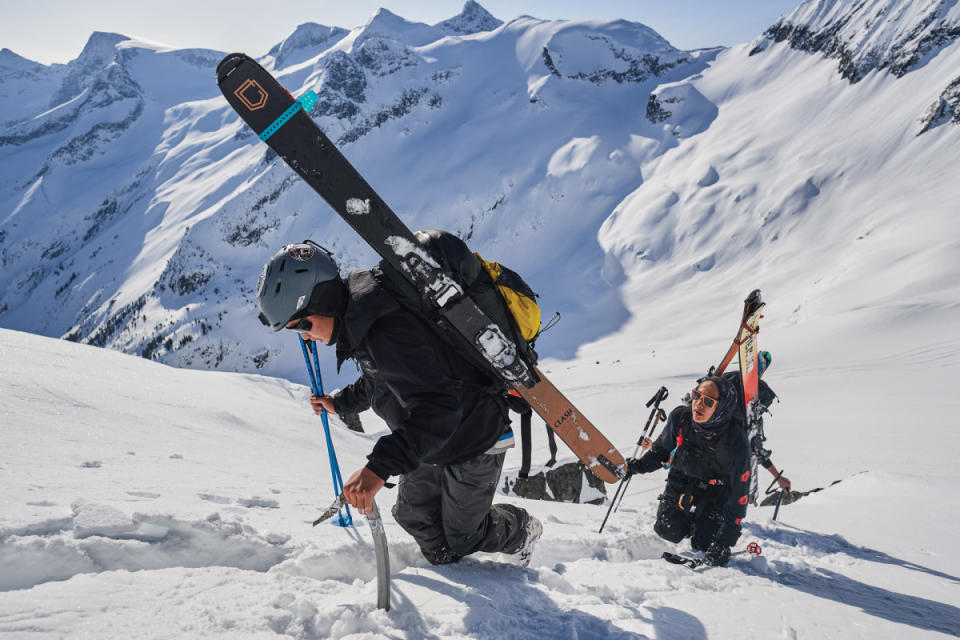
Photo: Blake Jorgenson
It was intimidatingly steep. It was a long way down. And conditions were objectively shit. It only made sense that the person the boys looked up to most—the woman who, months previous, helped spark the project then worked past injury so she could be here in this all-important moment—should show them the way. Side-slipping her snowboard into the throat, black rock soaring on either side, she searched in frustration for a place to make a comfortable turn. The slope was a mess. “Holy hell,” she said to herself.

Photo: Blake Jorgenson
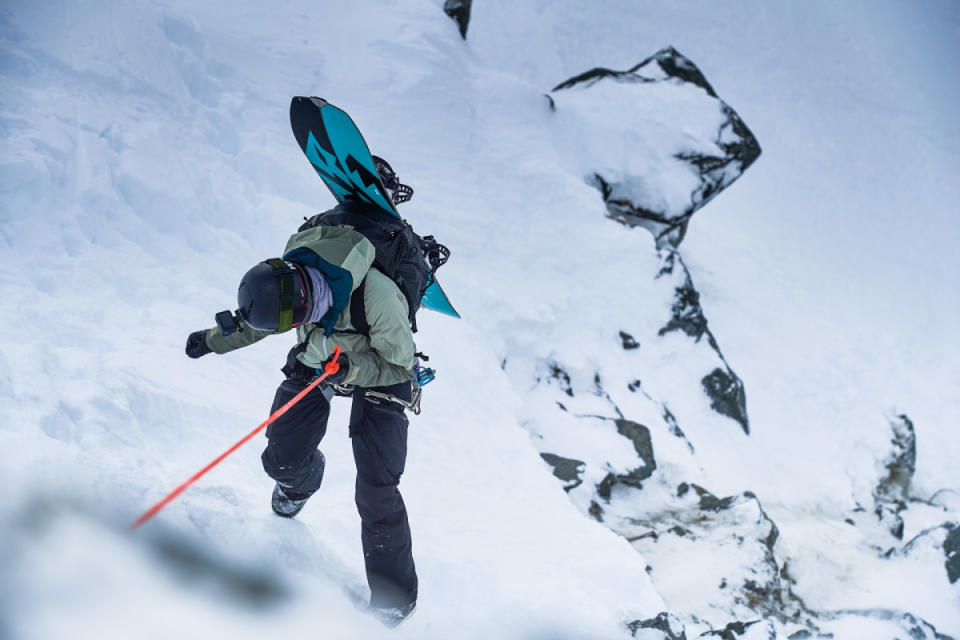
Photo: Blake Jorgenson
The boys watched from above. Finally, a toe-side turn. Solid. Then heel-side, but with the opposite outcome: The front edge caught in the manky snow, pitching her forward to rocket down the chute.
Tell a salty ski mountaineer that its peak barely brushes 8,520 feet, and British Columbia’s Mount Currie won’t raise many eyebrows—at least not by the Himalayan or Chamoniard standards of that fraternity. But mention how the north face drops 7,800 vertical feet nudging 45 degrees in places and their eyes might suitably widen.
In truth, Mount Currie is one of the continent’s most imposing ski objectives, appropriately chaptered in 50 Classic Ski Descents of North America and dutifully tagged in Cody Townsend’s multi-year film homage to that volume. Visitors to Pemberton’s organic farms, breweries and mountain-bike bonanza who find themselves scanning the serrated ridge and intersecting chutes that consume the town’s southern horizon can’t help but imagine the panoply of myth, menace and imagination inspired in those who dwell beneath the ramparts. Foremost in that conception are people of the Lil’wat Nation who’ve occupied the valley since time immemorial and whose name for their sacred peak, Ts’zil—“slides on the mountain”—channels its spooky geological animation: the rumbling, high-speed avalanches of winter and spring’s boulder-pocked, wet-snow monstrosities; the dust-cloud clatter of summer’s constant rockfall followed by a slurry of rain-fed autumn mudslides.
“It’s alive,” declares professional snowboarder Sandy Ward in the upcoming Telus Original/Arc’teryx film Slides on the Mountain, citing one of the reasons it’s no small feat to ski Mount Currie. “It’s always moving. Always sliding. It’s an entity. It’s power.”
Years before, reverence for the dynamic peak she’d gazed at her entire life and the unceded territory in which it rises had drawn Sandy to become the first Lil’wat Nation member to descend its storied face. Though she’d done it on a snowboard, the accomplishment stirred a thought: With so many coming from near and far to challenge Mount Currie, no Lil’wat had yet to do so on two planks; maybe, in this time of reclamation and reconciliation for Canada’s First Nations, it was time to change that.
The idea eventually found footing in the summer of 2022, when Sandy sat down with Morgan Fleury—her partner and a ski coach with the Indigenous Life Sport Academy (ILSA)—and Squamish-based filmmaker Seth Gillis to spitball a potential film project. Ideas were being bandied when Mount Currie entered the conversation, along with two Lil’wat youth—brothers Talon and Riki Pascal, the strongest skiers in the ILSA program.
The siblings share a love of skiing but are almost comically different in comportment. Riki, 15, is a live-out-loud bundle of crash-bang enthusiasm with a contagious laugh, while 18-year-old Talon is a quiet, introspective craftsman who listens from the shadows. Having coached them, Morgan figured they’d be into it; more importantly, he understood their capabilities and believed he and Sandy could teach them the skills needed to get up and down the peak safely. A Lil’wat skier descending Mount Currie would be a point of both connection and pride, but a couple of ILSA youth doing so would redline inspiration and aspiration for all.
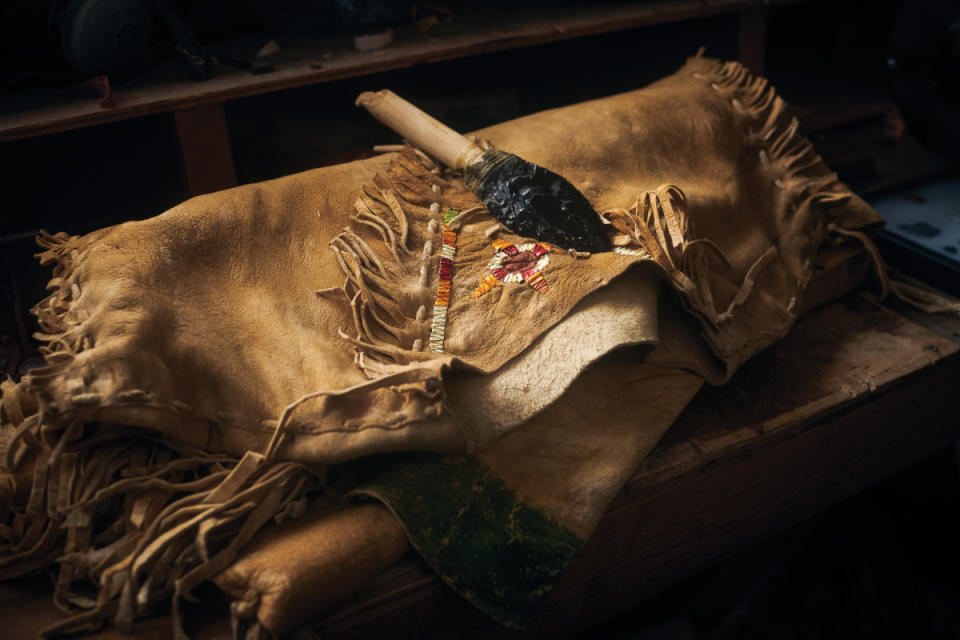
Photo: Blake Jorgenson
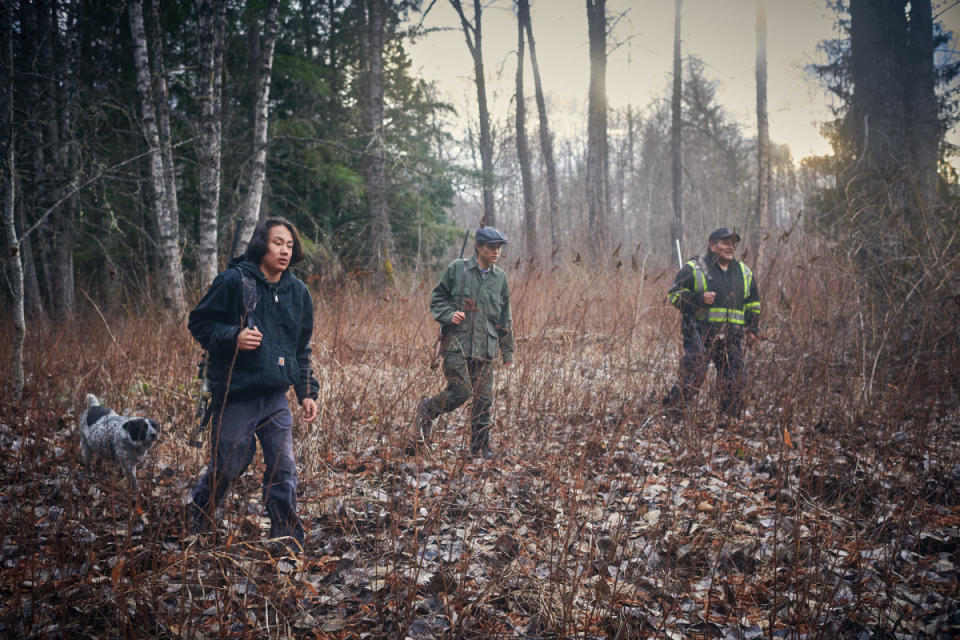
Photo: Blake Jorgenson
Morgan floated the idea with Ryan, the boys’ father. “I just kinda laughed and said I don’t know if they’re capable of doing it,” says Ryan. “Because you look at that mountain and it’s steep. It’s huge.”
Easygoing and ever-supportive, he was nevertheless game if they were. As soon as he asked, the boys were all in.
With a heavy agenda to get up to speed by mid-winter of 2022/23, the crew first met at a fall sit-down with the boys’ mother, Hiroko Takay-Pascal. “The kids didn’t say a word. They were just shy,” recalls Seth. “They livened up on the first day of filming, though, at Talon’s pit-house project.”
In the summer of 2020, along with a few friends, Talon began building a traditional pit house, or istken, a four-sided log pyramid erected over a large excavated living space. Though seemingly tangential to a training program of learning not only big-mountain ski skills but also how to use unfamiliar ski-touring, climbing and avalanche gear, it was actually the perfect kick off.
At a young age, Talon dreamed that his place in the world was to walk the path of his ancestors. And so he set out, methodical beyond the ken of the average teen, to play a role in restoring the forgotten skills of his people. Self-taught via books, tips from elders and a modern tool paramount to visualizing ancient human arts—YouTube—he’d become skilled enough at hide-tanning, bow-making, knapping (fashioning spear points, arrowheads and knives from stone) to give presentations and workshops. “I [once] said to Talon, ‘You were born a hundred years too late,” chuckles Ryan. “And after thinking about it, I was, ‘No, wait a minute, I think you were born at just the right time to start saving our culture.’ He’s bringing it back.”
With a deep interest in Indigenous history, Talon had also volunteered on archaeological projects jointly overseen by Lil’wat cultural technicians and university professors, and was about to begin his first term studying archaeology at Vancouver’s Simon Fraser University. Sudden demand to learn and get good at a whack of new skills appealed to his crafter/creator soul. “It’s easier for me to learn one thing to accomplish another when I’m interested in the final goal, and I was really interested in skiing Mount Currie,” he says. “The whole process was great. I was never bored. Everything we learned was useful.”
Riki, as well, drank it all in. “I learned so much over the whole season,” he recalls, shaking his head as if it had all yet to sink in. “It made me a way more confident skier.”
For Sandy Ward, the istken was also a point of reciprocation; she would mentor the boys in alpine savvy, but hoped to learn what she could from them about Lil’wat culture and traditions—bows and arrows and pit-houses being absent from her not-very-outdoor-oriented younger years.
Purchasing a snowboard at 15 had changed Sandy’s life with respect to both sport and indigeneity. Within two years she was on a First Nations snowboard team that evolved into ILSA. In short order she became both a coach and instructor, continuing to compete in halfpipe until knee injuries forced her out. As for many who dwelt in B.C.’s Sea to Sky region, one sport begat others, and, for Sandy, new ways to promote Indigenous involvement. Currently director of ILSA youth biking and climbing programs, backcountry co-lead for Indigenous Women Outdoors, athlete ambassador for Protect Our Winters Canada, and working toward mountain guide certification on a splitboard, Sandy began learning about Lil’wat geography only when she got into backcountry. “Wanting to know the traditional names [for] mountains and the reason we called them that... really sparked my interest in learning about our culture,” she told Pique Newsmagazine.
Of course, there’d be plenty of time for cultural exchange after the more pressing issue of the descent, something that didn’t seem entirely certain on the group’s first mid-December ski day. Teen senders to the core, to this point skiing had been all about fun for the boys, control a distant afterthought. “Sandy and I kind of turned and looked at each other and wondered what we’d done,” recalls Seth.
Morgan knew better. Seeing the very aggression that could be harnessed for positive purpose, he stepped the boys into Whistler Blackcomb’s steepest lines. Jump turns. Low stance. Hand-placement. Angulation. An immediate shift took place. With no illusions about what they’d bought into, there was real desire to learn what was necessary. The next few months were a blur of ski sessions, avalanche training, ski-touring missions, computer investigation and binocular-and-finger-trace route-finding culminating in a February shakedown tour to ski Blackcomb’s infamous DOA couloir. Gratifyingly, the pair shredded the 1,000-vertical-foot classic.
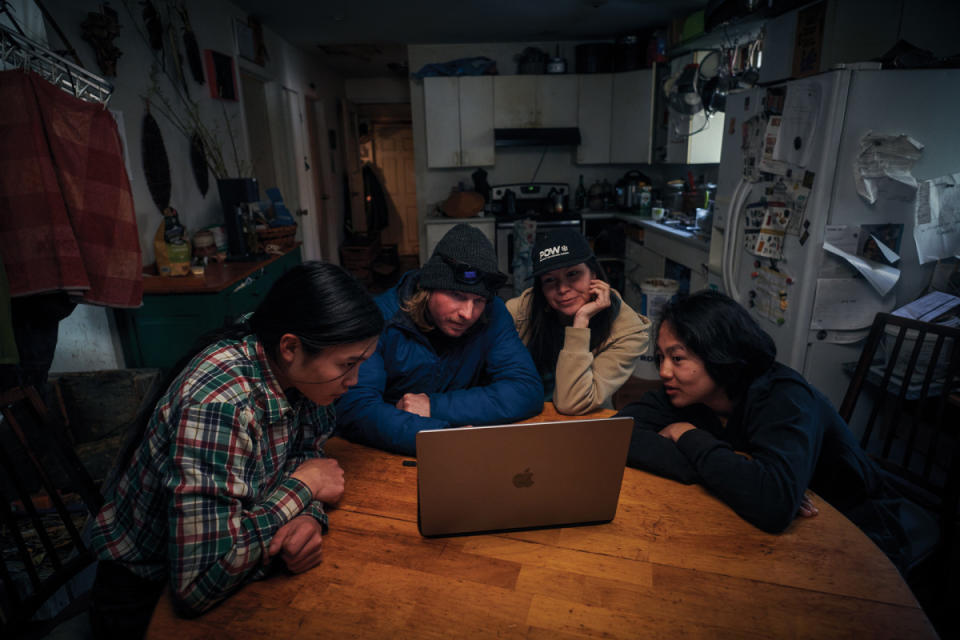
Photo: Blake Jorgenson
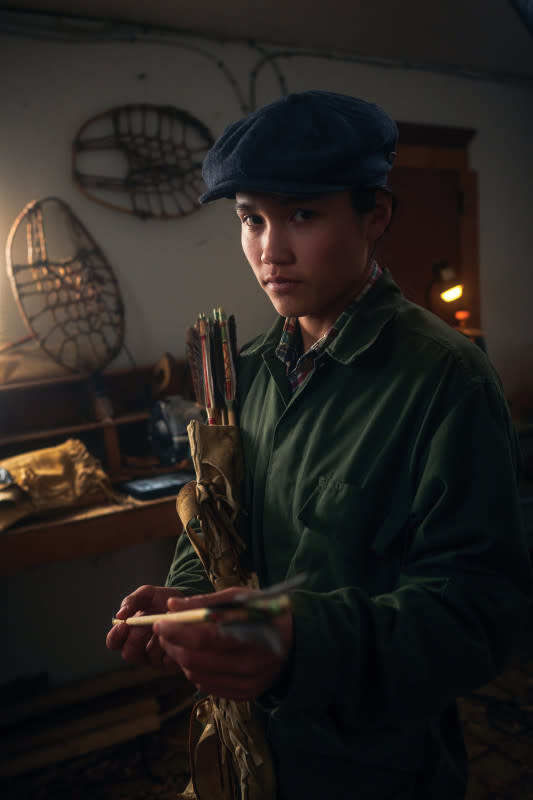
Photo: Blake Jorgenson
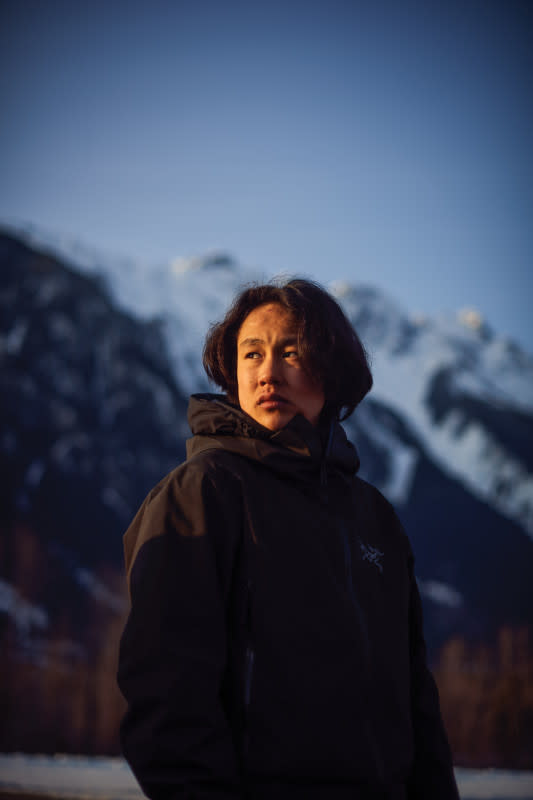
Photo: Blake Jorgenson
After two months, both mentors and mentees felt ready. Doubt, when there was any, focused on conditions—lining up stability, snow and sun. The hope had been to ski Ts’zil in February when there was snow to valley bottom, but it wasn’t a great year in the Coast Mountains for alpine objectives; steeper lines hadn’t filled in enough to lessen their angle. “There were literally two days all winter it was in condition,” notes Seth. “And we missed the first one, so everyone was on standby.”
Finally, in March, the call came. On the eve of the descent, the crew gathered around a fire at the Pascal residence. The boys professed excitement about the skiing but showed much more convincing disdain for the required tour and climb to get there. The day before, Hiroko had made an offering for safe passage—food, an herbal smudge, and her favorite basket.
Mount Currie’s Central Couloir route exits the eponymous tube skier’s left into a pseudo-cirque. It then skirts right of a moraine feature and follows high along a wall before descending into an alley between trees islands. Part way down that chute, it hooks into a long right-hand traverse through trees and into the bottom of the widest and least avalanche-prone of Currie’s three main funnel chutes. But those complexities were yet to unfold as the group huddled on the drop-in when Sandy fell.
Fortunately, she didn’t tumble far, experience allowing her to self-arrest in better snow a couple hundred feet down. But the calf muscle she’d torn a few weeks prior was toast; at first, Sandy thought she could side-slip the rest, but this was no place to be a hero. She’d eventually get herself to a pick-up zone on the exit route and be safely heli-lifted off, a 90-minute delay that prompted anxiety in some, somnolence in others, as Talon managed to take a nap. “Mentally, everybody’s like, ‘Whoa, this is what it’s like when you mess it up,’” says Morgan of the effect on a group from a fall, which can be both negative and positive.
“When I saw the fall I immediately thought I didn’t want to be part of this,” says Riki. Ultimately, however, he found it inspired him to stay calm, “to keep my brain from exploding, you know?”
It worked. When they got underway again, Riki was more ready than he let on. “Here goes nothin’,” he joked to Talon. “See you at the bottom.”
Wisely side-slipping the start and using every ski skill garnered in the past months, Riki made a turn, then two, then five. Finding a rhythm, he was soon eating up couloir vertical. Talon followed even more confidently, feeding off his brother. Accident and difficulties behind, they skied the rest of the route without incident, even finding some good powder after the traverse. The bushwhack exit still required concentration, but there was a celebratory mood.
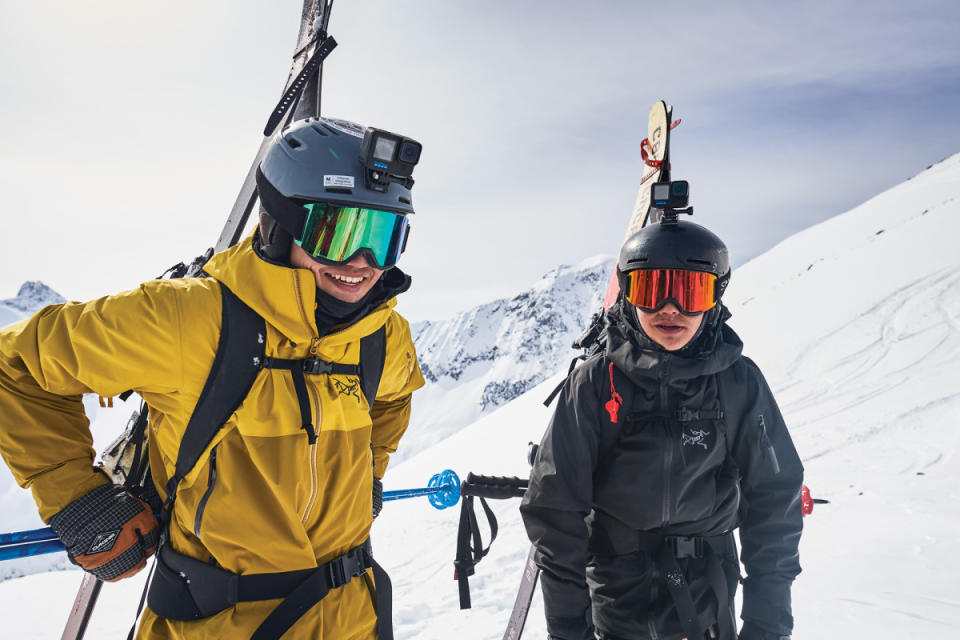
Photo: Blake Jorgenson
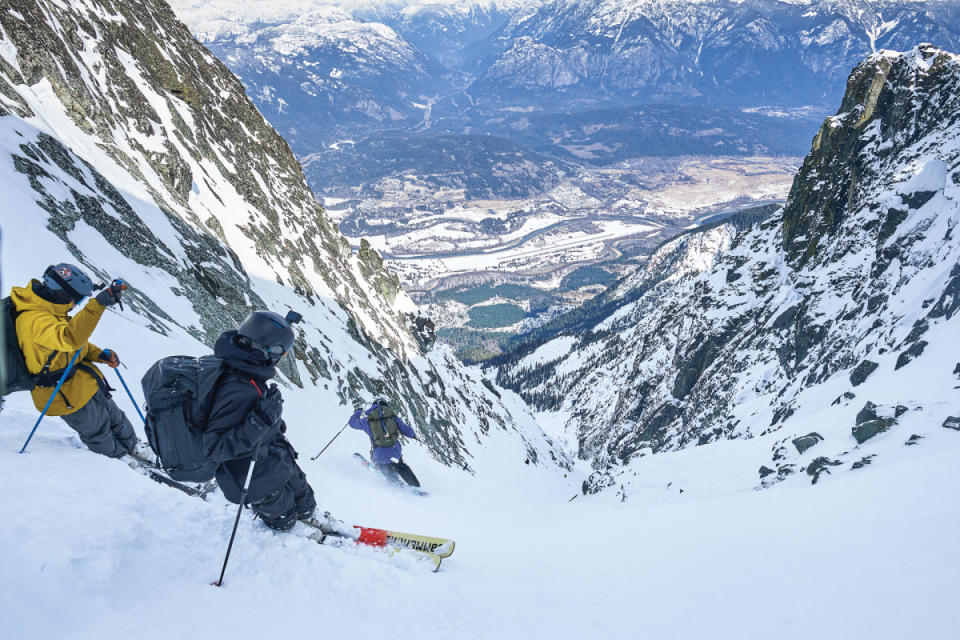
Photo: Blake Jorgenson
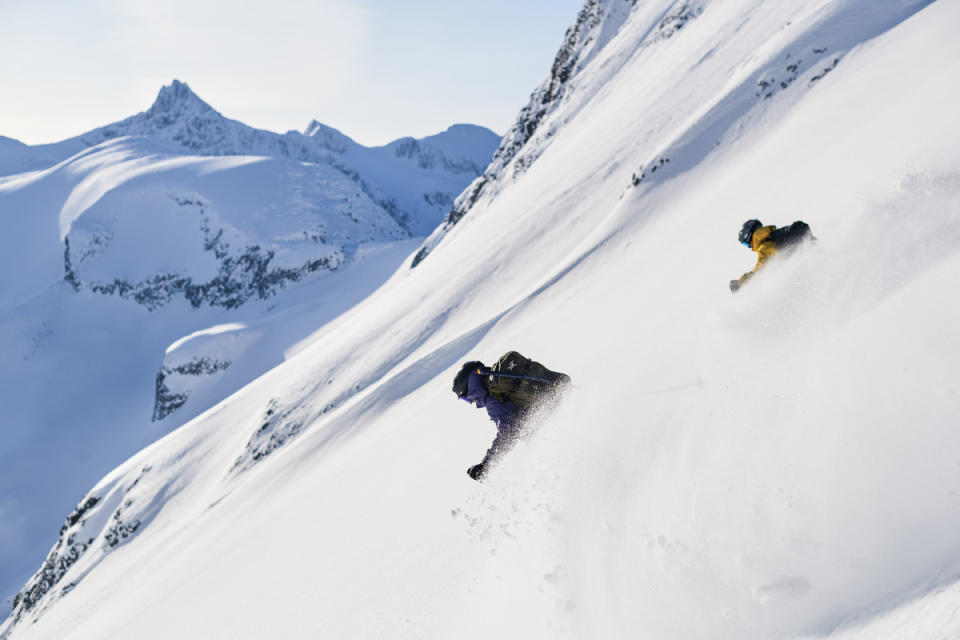
Photo: Blake Jorgenson
Talon and Riki’s parents watched the achievement from a perch across the valley—as had, apparently, many. Unbeknownst to the skiers, their descent became a de facto community event. People left their houses to watch. Even Chief Dean Nelson followed with binoculars. All saw the boys’ courage to take on the mountain as part of the Lil’wat’s broader emergence into the light, asserting themselves in new ways on the land their people had been part of for millennia.
Ts’zil has pride of place on the B.C. Aboriginal Tourism Association’s map of cultural attractions, its face described as being “etched by the travels of a giant two-headed serpent,” with rocks on its northwest ridgeline representing two Lil’wat hunters transformed to stone. Now it had been etched by two ski-loving kids who grew up in its shadow, and the only thing transformed was the future.
In September, Talon and I arrange to meet up at, apropos, the Mount Currie Coffee Company in Pemberton. He arrives—limping from a hiking injury—dressed smartly in new jeans and a button-up shirt, sporting a natty flat cap over long black hair he keeps in braids behind his ears. A T-shirted Riki explodes out of the ether behind him, having walked into town from an overnight campout, unable to get a ride because his phone had died.
With fall in the air, March was ancient history in a young life. But I’m interested to know what lingered from the experience. It would take some work. First: many hands and thousands of hours later, Talon’s pit house was complete and he was off to university to start a new chapter of cultural exploration. Second: Riki had his eye on hunting season. Then, somehow, thoughts pry themselves loose, like the rockfall on Ts’zil.
“I didn’t know what to expect,” offers Riki. “I was freaked out by the rappel and the steepness of the first part, but after four or five turns I was fine.”
“The first few turns were definitely the waking-up point for everyone; I wouldn’t say it was fun but it was still enjoyable,” says Talon. “And it had an effect—to realize I was able to do something like that without fear of being seriously injured. All the training paid off. I’d do it again…”
“… without the cameras,” laughs Riki.
Then Talon drifts into searching thought. “It’s not just a mountain you see every day anymore,” he muses. “It’s something else… something that’s always going to be part of me.”
It makes sense. Sharing what she’s learned about Lil’wat culture in ILSA and elsewhere, Sandy finds folks grateful to make a deeper connection to the land and better understand the history, hoping it instills more respect for the territory—and the Lil’wat, for whom the people and the land are one.
“It’s not about reclaiming the land. We never gave up our land,” she sums at the end of the film. “It’s about reconnecting and getting back out there. And it’s there for us when we’re ready for it.”
Watch the film documentary of this project HERE
The above article runs as the Intro page in the current '23/'24 print issue of POWDER. Purchase your copy HERE!


